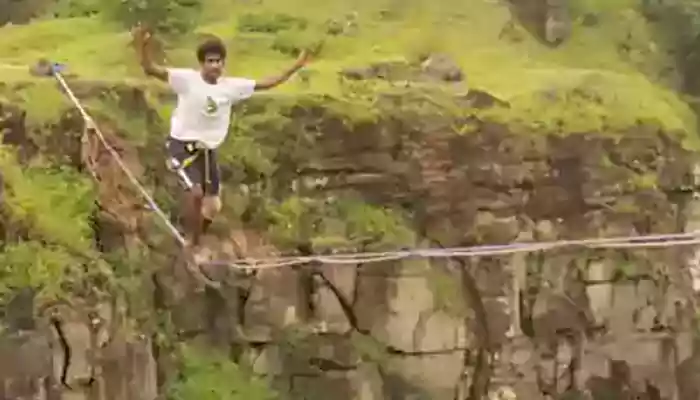Balancing Act: How Are Indian Slackliners Defying Gravity? Walking the Tightrope Between Tradition and Extreme Sports
Slacklining, a practice that involves walking or balancing along a suspended length of flat webbing, traces its roots back to ancient civilizations. In India, it finds its connection with traditional rope walking, a skill often demonstrated at fairs and festivals. The modern incarnation of slacklining, however, has taken this age-old art form to new heights, quite literally.
- Sayan Guha
- 31 October, 2023
- 2 mins ago

Balancing Act: How Are Indian Slackliners Defying Gravity? Walking the Tightrope Between Tradition and Extreme Sports
Slacklining, a practice that involves walking or balancing along a suspended length of flat webbing, traces its roots back to ancient civilizations. In India, it finds its connection with traditional rope walking, a skill often demonstrated at fairs and festivals. The modern incarnation of slacklining, however, has taken this age-old art form to new heights, quite literally.
From Humble Beginnings to Gravity-Defying Feats
Indian slackliners began their journey as a small, tight-knit community of thrill-seekers and adventurers. Armed with determination and a passion for pushing their limits, they transformed what was once a pastime into a bona fide sport. What started as simple walks between trees in local parks evolved into breathtaking highlines suspended hundreds of feet above the ground.

Credit: @samarfarooqui
The Pioneers: India's Slacklining Trailblazers
The journey of Indian slacklining would be incomplete without mentioning the pioneers who paved the way for others. Artists like Samar Farooqui, Sarveshwaran, and Manikandan have been at the forefront of the Indian slacklining scene, showcasing their incredible balancing acts both nationally and internationally. Their awe-inspiring performances have captivated audiences and inspired countless individuals to take up the sport.
Crossing Boundaries: The Cultural Exchange of Slacklining
Slacklining isn't just about physical prowess; it's a means of cultural exchange. Indian slackliners have collaborated with international artists and participated in global festivals, sharing their skills and imbibing the techniques and traditions of the global slacklining community. This cross-cultural exchange has enriched the Indian slacklining landscape.
The Ultimate Balancing Act: Slacklining Competitions
Competitions have become the proving grounds for Indian slackliners to showcase their skills. Events like the Indian Nationals and Slackline World Cup have seen participants defy gravity with incredible flips, tricks, and walks on narrow webbing. These competitions have not only provided a platform for talent but have also elevated the sport's status in the country.
Challenging the Norms: Breaking Gender Barriers
Slacklining in India isn't confined to any particular gender. Female slackliners like Shyamala and Vandana Goswami have shattered stereotypes, demonstrating that balance and grace know no boundaries. Their participation has encouraged more women to step onto the slackline and embrace the sport.
Training the Next Generation: Slackline Academies
As the sport gains momentum, slackline academies and training centres have emerged across India. These institutions offer coaching, equipment, and a sense of community for aspiring slackliners. They aim to nurture talent and ensure that the legacy of Indian slacklining continues to grow.
The Thrill of the Highline: Pushing Limits
One of the most daring aspects of slacklining is highlighting. Indian slackliners have taken on this extreme challenge by setting up lines at dizzying heights across scenic locations. Conquering the fear of heights and executing breathtaking walks on highlines has become a hallmark of their skills.
Balancing Dreams and Gravity
Indian slackliners are more than just athletes; they are artists defying gravity with every step they take on the narrow webbing. Their journey from traditional rope walking to modern slacklining is a testament to the human spirit's boundless desire to explore new horizons.
As they continue to push the limits of balance and creativity, they inspire us all to pursue our dreams, even when the path seems as narrow as a slackline. In their balancing act, they find not only equilibrium but also a profound sense of freedom, reminding us that the sky is not the limit—it's just the beginning.









